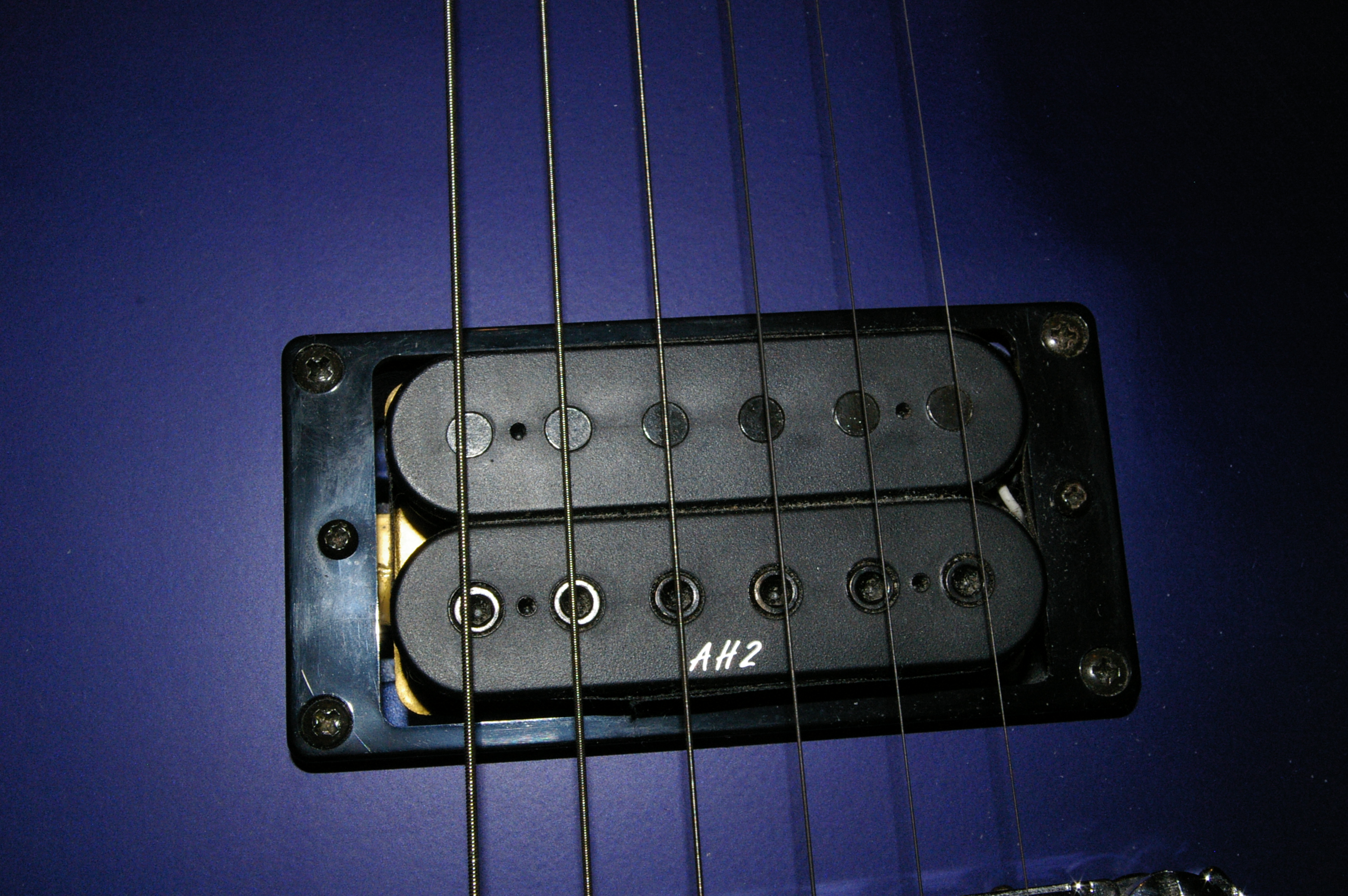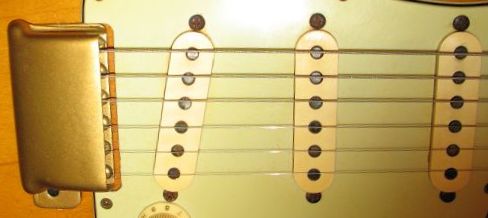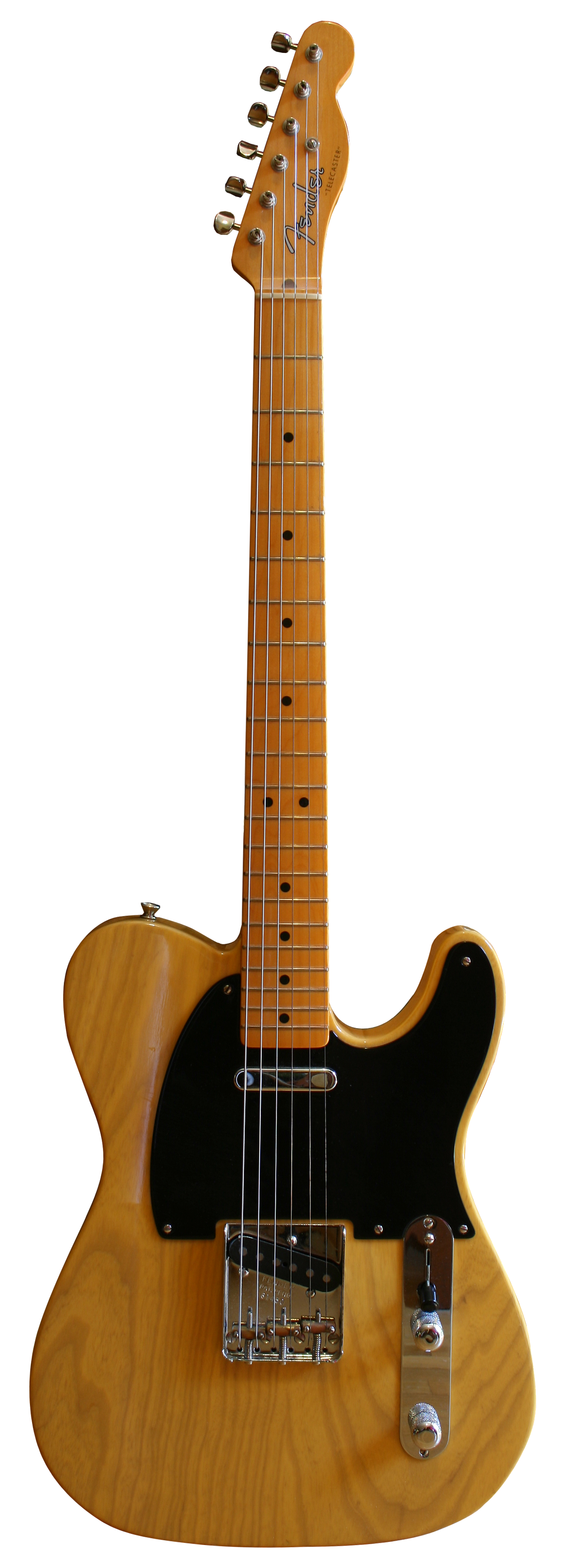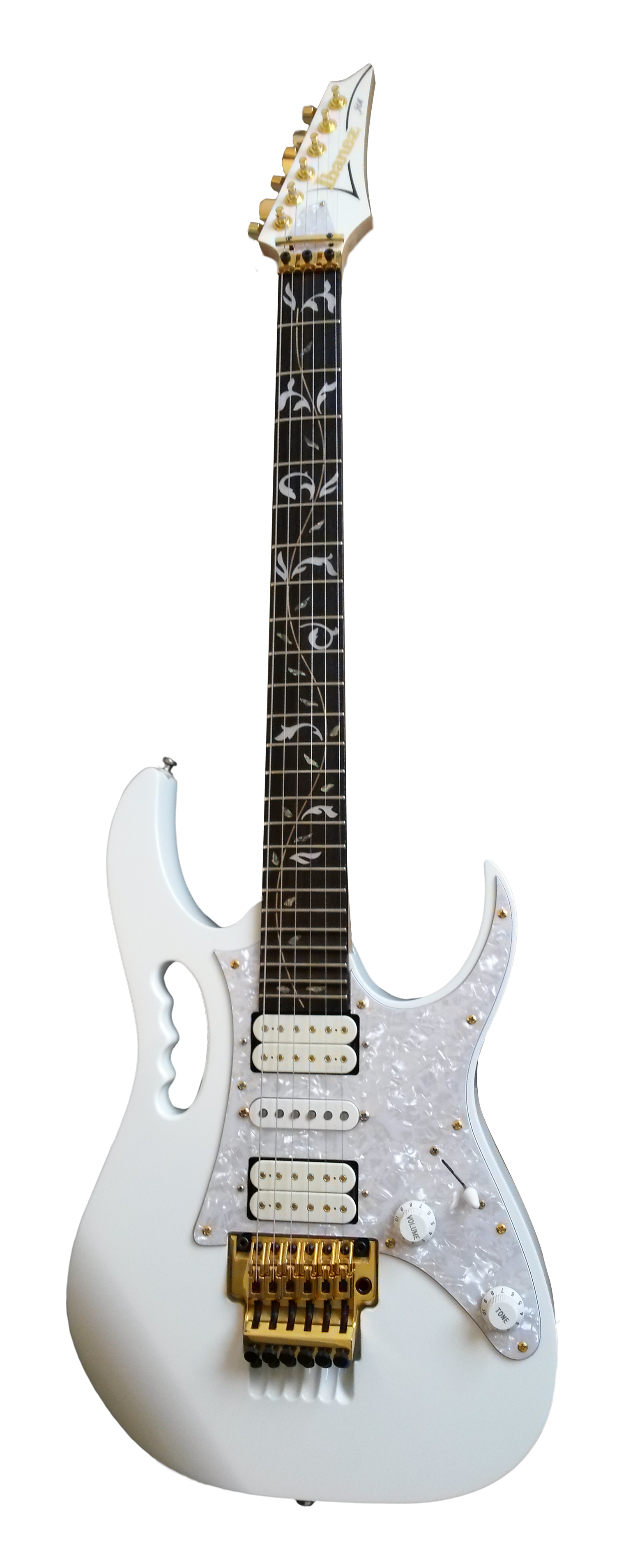|
Humbucker
A humbucking pickup, humbucker, or double coil, is a type of guitar pickup that uses two wire coils to cancel out the noisy interference picked up by coil pickups. In addition to electric guitar pickups, humbucking coils are sometimes used in dynamic microphones to cancel electromagnetic hum. Humbuckers are one of the two main types of guitar pickup, the other being single coil. History The "humbucking coil" was invented in 1934 by Electro-Voice, an American professional audio company based in South Bend, Indiana that Al Kahn and Lou Burroughs incorporated in 1930 for the purpose of manufacturing portable public address equipment, including microphones and loudspeakers. The twin coiled guitar pickup invented by Arnold Lesti in 1935 is arranged as a humbucker, and the patent USRE20070 describes the noise cancellation and current summation principles of such a design. This "Electric Translating Device" employed the solenoid windings of the pickup to magnetize the steel strin ... [...More Info...] [...Related Items...] OR: [Wikipedia] [Google] [Baidu] |
PAF (pickup)
A P.A.F., or simply PAF ("Patent Applied For"), is an early model of the humbucker guitar pickup invented by Seth Lover in 1955. Gibson began use of the PAF on higher-model guitars in late 1956 and stopped in late 1962. They were replaced by the Patent Number (Pat No) pickup, essentially a refined version of the PAF. These were in turn replaced by "T-Top" humbuckers in 1967, and production ended in 1975. Though it is commonly mistaken as the first humbucker pickup, the PAF was the first humbucker to gain widespread use and notoriety. The PAF is an essential tonal characteristic of the now-famous 1957–1960 Gibson Les Paul Standard guitars, and pickups of this type have gained a large following. History Development In the mid-1950s Gibson looked to create a new guitar pickup different from existing popular single coil designs. Gibson had already developed the Charlie Christian pickup and P-90 in the 1930s and 40s; however, these designs—like competitor Fender's single-coil p ... [...More Info...] [...Related Items...] OR: [Wikipedia] [Google] [Baidu] |
Guitar Pickup
A pickup is a transducer that captures or senses mechanical vibrations produced by musical instruments, particularly stringed instruments such as the electric guitar, and converts these to an electrical signal that is amplified using an instrument amplifier to produce musical sounds through a loudspeaker in a speaker enclosure. The signal from a pickup can also be recorded directly. Most electric guitars and electric basses use magnetic pickups. Acoustic guitars, upright basses and fiddles often use a piezoelectric pickup. Magnetic pickups A typical magnetic pickup is a transducer (specifically a variable reluctance sensor) that consists of one or more permanent magnets (usually alnico or ferrite) wrapped with a coil of several thousand turns of fine enameled copper wire. The magnet creates a magnetic field which is focused by the pickup's pole piece or pieces. The permanent magnet in the pickup magnetizes the guitar string above it. This causes the string to generate a mag ... [...More Info...] [...Related Items...] OR: [Wikipedia] [Google] [Baidu] |
Pick Up (music Technology)
A pickup is a transducer that captures or senses mechanical vibrations produced by musical instruments, particularly stringed instruments such as the electric guitar, and converts these to an electrical signal that is amplified using an instrument amplifier to produce musical sounds through a loudspeaker in a speaker enclosure. The signal from a pickup can also be recorded directly. Most electric guitars and electric basses use magnetic pickups. Acoustic guitars, upright basses and fiddles often use a piezoelectric pickup. Magnetic pickups A typical magnetic pickup is a transducer (specifically a variable reluctance sensor) that consists of one or more permanent magnets (usually alnico or ferrite) wrapped with a coil of several thousand turns of fine enameled copper wire. The magnet creates a magnetic field which is focused by the pickup's pole piece or pieces. The permanent magnet in the pickup magnetizes the guitar string above it. This causes the string to generate a ... [...More Info...] [...Related Items...] OR: [Wikipedia] [Google] [Baidu] |
Gibson Les Paul
The Gibson Les Paul is a solid body electric guitar that was first sold by the Gibson Guitar Corporation in 1952. The guitar was designed by factory manager John Huis and his team with input from and endorsement by guitarist Les Paul. Its typical design features a solid mahogany body with a carved maple top and a single cutaway, a mahogany set-in neck with a rosewood fretboard, two pickups with independent volume and tone controls, and a stoptail bridge, although variants exist. The Les Paul was originally offered with a gold finish and two P-90 pickups. In 1957, humbucking pickups were added, along with sunburst finishes in 1958. The 1958–1960 sunburst Les Paul, today one of the best-known electric guitar types in the world, was considered a commercial failure, with low production and sales. For 1961, the Les Paul was redesigned into what is now known as the Gibson SG. The original single-cutaway, carved top bodystyle was re-introduced in 1968. The Les Paul has been produce ... [...More Info...] [...Related Items...] OR: [Wikipedia] [Google] [Baidu] |
Seth Lover
Seth E. Lover (January 1, 1910 in Kalamazoo, Michigan – January 31, 1997 in Garden Grove, California) was a designer of amplifiers and musical instrument electronics and effects. He is most famous for developing the Gibson humbucker or hum-cancelling electric stringed instrument pickup, most often used on the electric guitar. Life and career Seth Lover began working with electronics as a child, and continued working with them during and after his first service with the US Army in the 1930s. He then worked in an electronics shop in Kalamazoo, repairing radios and building amplifiers. In the 1940s he worked for Gibson Guitars before joining the service a second time during World War II. During the rest of the 1940s and 1950s, his career fluctuated between working for Gibson and the US Navy. He developed the humbucking pickup for Gibson in 1955, and designed the first fuzztone distortion device, called the Maestro, in 1961. He stayed with Gibson until 1967 when he took a designi ... [...More Info...] [...Related Items...] OR: [Wikipedia] [Google] [Baidu] |
Fender Stratocaster
The Fender Stratocaster, colloquially known as the Strat, is a model of electric guitar designed from 1952 into 1954 by Leo Fender, Bill Carson, George Fullerton, and Freddie Tavares. The Fender Musical Instruments Corporation has continuously manufactured the Stratocaster since 1954. It is a double- cutaway guitar, with an extended top "horn" shape for balance. Along with the Gibson Les Paul, Gibson SG, and Fender Telecaster, it is one of the most-often emulated electric guitar shapes. "Stratocaster" and "Strat" are trademark terms belonging to Fender. Guitars that duplicate the Stratocaster by other manufacturers are sometimes called ''S-Type'' or ''ST-type'' guitars. The guitar introduced into the popular market several features that were innovative for electric guitars in the mid-1950s. The distinctive body shape, which has become commonplace among electric guitars, was revolutionary for the time period, and for the first time a mass-market electric guitar did not significan ... [...More Info...] [...Related Items...] OR: [Wikipedia] [Google] [Baidu] |
Fender Telecaster
The Fender Telecaster, colloquially known as the Tele , is an electric guitar produced by Fender. Together with its sister model the Esquire, it is the world's first mass-produced, commercially successful Les Paul had built a prototype solid body electric guitar known as "The Log" in the 1940s, but could not market his invention. Gibson produced the Gibson Les Paul guitar in 1952 after bringing on Paul to help design a commercial model to compete with Fender. Likewise, Paul Bigsby and Merle Travis designed and built a solid-body electric in 1948, but this was a one-off guitar. solid-body electric guitar. Its simple yet effective design and revolutionary sound broke ground and set trends in electric guitar manufacturing and popular music. Introduced for national distribution as the Broadcaster in the autumn of 1950 as a two-pickup version of its sister model, the single-pickup Esquire, the pair were the first guitars of their kind manufactured on a substantial scale. A trad ... [...More Info...] [...Related Items...] OR: [Wikipedia] [Google] [Baidu] |
Superstrat
Superstrat is a name for an electric guitar design that resembles a Fender Stratocaster but with differences that clearly distinguish it from a standard Stratocaster, usually to cater to a different playing style. Differences typically include more pointed, aggressive-looking body and neck shapes, different woods, increased cutaways (resulting in deeper horns) to facilitate access to the higher frets, increased number of frets, contoured heel facilitating easier higher fret access, usage of humbucking pickups and locking vibrato systems, most commonly the Floyd Rose. There is no formal definition of a superstrat; the categorization is still largely left to popular opinion and depends greatly on the artist(s) associated with a particular model and how it is marketed. History Origin in custom modifications With the increased popularity of heavy metal music during the early 1980s, guitarists began seeking out guitars more suited to the new style, both in terms of looks (more ... [...More Info...] [...Related Items...] OR: [Wikipedia] [Google] [Baidu] |
Rickenbacker
Rickenbacker International Corporation is a string instrument manufacturer based in Santa Ana, California. The company is credited as the first known maker of electric guitars – a steel guitar in 1932 – and today produces a range of electric guitars and basses. Rickenbacker twelve-string guitars were favoured by George Harrison of the Beatles, Roger McGuinn of the Byrds, Pete Townshend of the Who, and Tom Petty. Players of the six-string include John Lennon of the Beatles, John Fogerty of Creedence Clearwater Revival, Paul Weller of the Jam, John Kay of Steppenwolf, Peter Buck of R.E.M., Johnny Marr of the Smiths, and Susanna Hoffs of the Bangles. Players who have used Rickenbacker basses include Paul McCartney of the Beatles, Lemmy Kilmister of Motörhead, Cliff Burton of Metallica, Roger Glover and Glenn Hughes of Deep Purple, Chuck Panozzo of Styx, Dougie Thomson of Supertramp, Paul Wilson of Snow Patrol, Bruce Foxton of the Jam, Roger Waters of P ... [...More Info...] [...Related Items...] OR: [Wikipedia] [Google] [Baidu] |
Antenna (radio)
In radio engineering, an antenna or aerial is the interface between radio waves propagating through space and electric currents moving in metal conductors, used with a transmitter or receiver. In transmission, a radio transmitter supplies an electric current to the antenna's terminals, and the antenna radiates the energy from the current as electromagnetic wave In physics, electromagnetic radiation (EMR) consists of waves of the electromagnetic (EM) field, which propagate through space and carry momentum and electromagnetic radiant energy. It includes radio waves, microwaves, infrared, (visib ...s (radio waves). In Receiver (radio), reception, an antenna intercepts some of the power of a radio wave in order to produce an electric current at its terminals, that is applied to a receiver to be Amplifier, amplified. Antennas are essential components of all radio equipment. An antenna is an array of conductor (material), conductors (Driven element, elements), elect ... [...More Info...] [...Related Items...] OR: [Wikipedia] [Google] [Baidu] |
Mains Hum
Mains hum, electric hum, cycle hum, or power line hum is a sound associated with alternating current which is twice the frequency of the mains electricity. The fundamental frequency of this sound is usually double that of fundamental 50/60 Hz, ''i.e.''100/120Hz, depending on the local power-line frequency. The sound often has heavy harmonic content above 50/60Hz. Because of the presence of mains current in mains-powered audio equipment as well as ubiquitous AC electromagnetic fields from nearby appliances and wiring, 50/60Hz electrical noise can get into audio systems, and is heard as mains hum from their speakers. Mains hum may also be heard coming from powerful electric power grid equipment such as utility transformers, caused by mechanical vibrations induced by magnetostriction in magnetic core. Onboard aircraft (or spacecraft) the frequency heard is often higher pitched, due to the use of 400 Hz AC power in these settings because 400 Hz transformers are much smaller and ligh ... [...More Info...] [...Related Items...] OR: [Wikipedia] [Google] [Baidu] |









